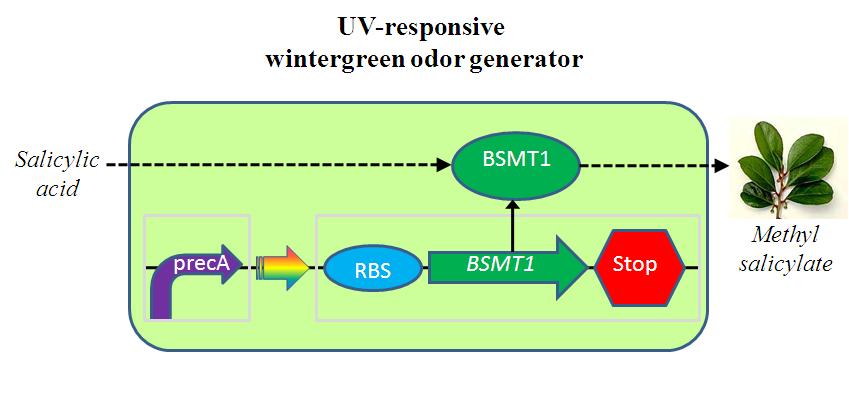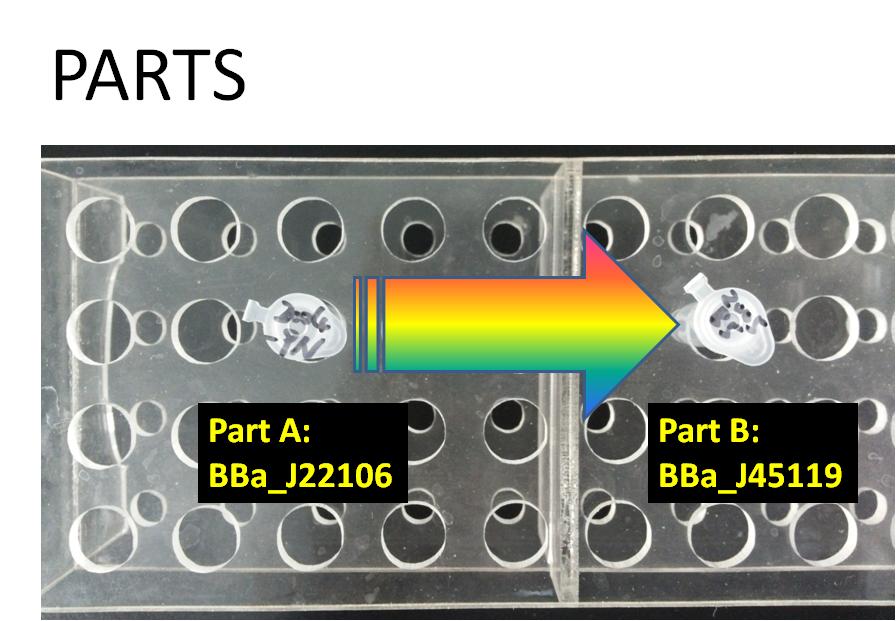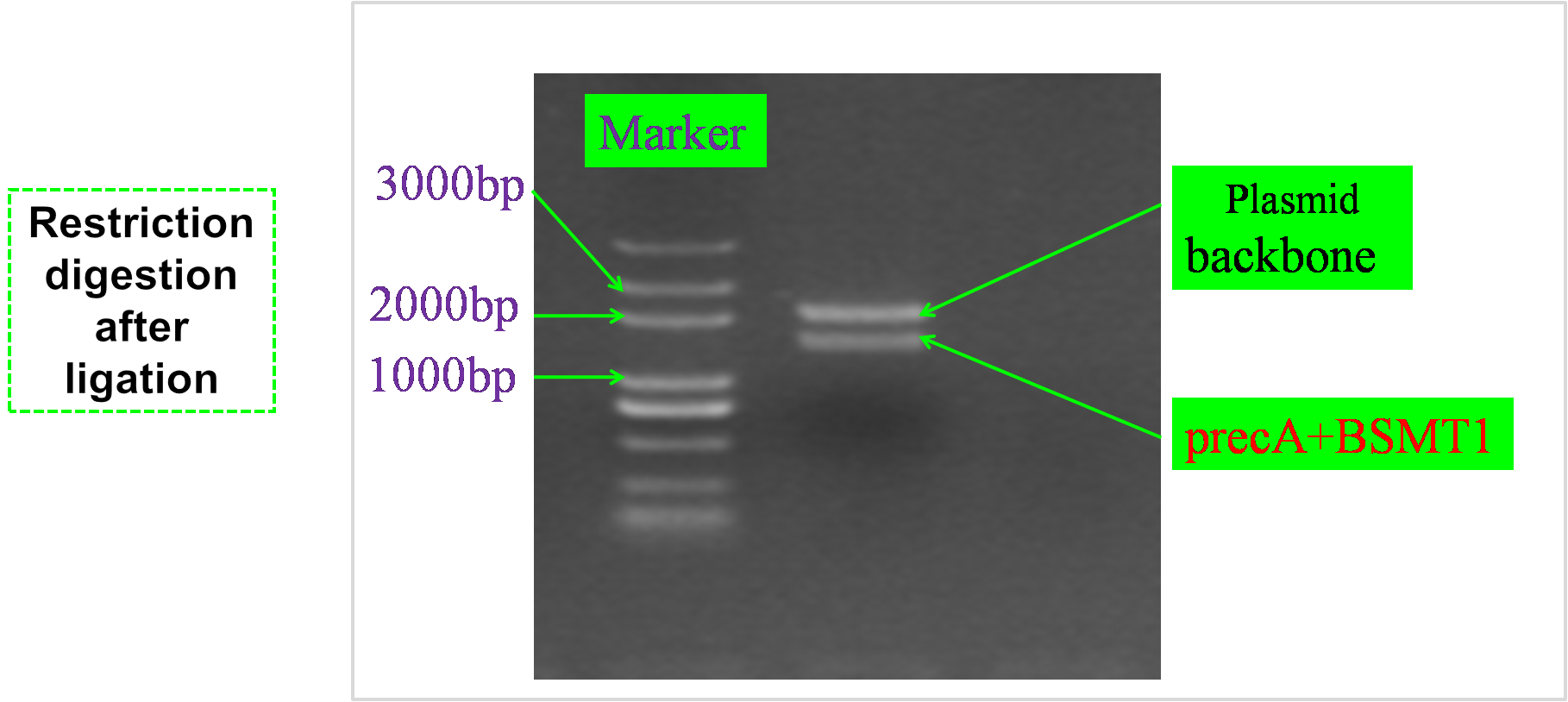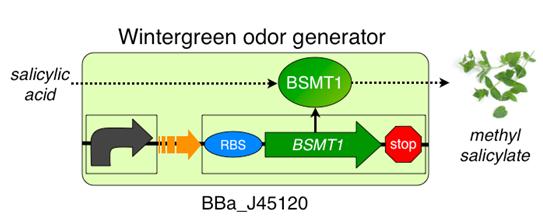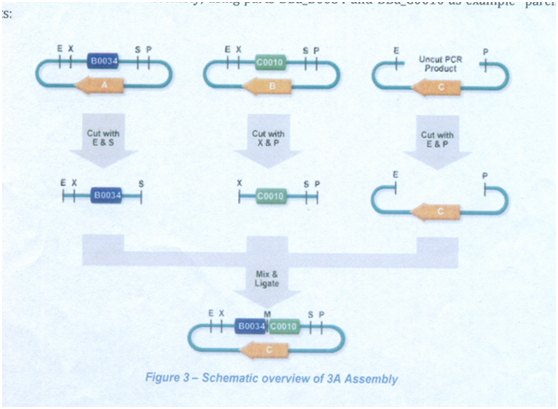Team:Beijing HDFLS High/Project
From 2013hs.igem.org
(→ABSTRACT) |
(→Parts) |
||
| Line 12: | Line 12: | ||
[[Image:PARTS.JPG|center|600px]] | [[Image:PARTS.JPG|center|600px]] | ||
| - | == | + | == RESULT == |
| - | === | + | === Enzyme digestion after ligation === |
| - | + | [[Image:PARTAB.JPG|center|500px]] | |
| - | + | ||
| - | + | ||
=== REPORTER : "Wintergreen odor enzyme (BMST1) generator" (BBa_J45119) === | === REPORTER : "Wintergreen odor enzyme (BMST1) generator" (BBa_J45119) === | ||
Revision as of 14:21, 5 June 2013
Contents |
ABSTRACT
The UV-responsive wintergreen odor generator catalyzes the conversion of the precursor salicylic acid to the wintergreen odor methyl salicylate under extensive UV irradiation. The biosynthetic device is composed of two transcriptional devices: Rec A (SOS) promoter (BBa_J22106) and a wintergreen odor enzyme generator (BBa_J45119). The odor generator takes as input extensive UV irradiation and produce as output an enzyme that catalyzes production of an odor from a chemical precursor.
PARTS
Part A:BBa_J22106 rec A (SOS) Promoter
Extensive UV irradiation impings on heavily DNA damage, resulting in a single-strand DNA occuring, which activates RecA protein.Then,RecA protein leads to the expression of about 20 different repair proteins to contract DNA damamage.RecA protein is the central regulator in SOS repair system.Rec A (SOS) Promoter is available in 2004 registry part plate.
Part B:BBa_J45119 Wintergreen odor enzyme (BMST1) generator
BBa_J45119 takes as input a transcriptional signal (PoPS) and produce as output the BMST1 enzyme that catalyzes production of methyl salicylate from salicylic acid. Methyl salicylate has a wintergreen smell. Wintergreen odor enzyme (BMST1) generator is availabe in 2005 registry part plate.
RESULT
Enzyme digestion after ligation
REPORTER : "Wintergreen odor enzyme (BMST1) generator" (BBa_J45119)
The wintergreen odor generator (BBa_J45120) catalyzes the conversion of the precursor salicylic acid to the odor methyl salicylate that has a wintergreen smell. The biosynthetic device is composed of two transcriptional devices: a constitutive transcription source (BBa_R0040) and an odor enzyme generator (BBa_J45119). Odor enzyme generators take as input a transcriptional signal and produce as output an enzyme that catalyzes production of an odor from a chemical precursor.
Method
Experimental theory
“3A(antibiotic)” Assembly is one way of assembling two strandard biological parts together. “3A(antibiotic)” Assembly uses the restriction sites in the prefix and suffix of the two parts to assemble them into the new composite part. The composite part will have the same prefix and suffix as the ‘parent’ parts.
This time choose RecA as promoter and wintergreen odor biosynthetic system as reporter. The uesful part of RecA are cut out by enzymese ECORI and PSTI ,and we also need ECORI and PSTI to cut the useful part of wintergreen odor biosynthetic system ,and then we need to connect them together to completely the whole system.
Step
STEP1: GROWING
(Make sure we have enough copies of BBa_J22106 and BBa_J45119.)
- PART1:
- Clean the lab bench
- Label the agar plates with names of partA and parB and partC (partA:J22106 partB:J45119 partC: BBa_J45199banana)
- Use an inoculating loop to transfer some cells from the PartA agar stab to the appropriate agar plate .Dip an inoculating loop into the stab at the same location, and streak the bacteria onto the agar plate in a zig-zag pattern
- Repeat step 3 for partB and partC
- Place the agar plates into the incubator with the agar facing down. Incubate the agar plates at 37 degrees for 14-16hours. Alternately, incubate at room temperature for 24-30 hours.
- PART2
- Clean the lab bench
- Remove the agar plates from fridge
- Add 5ml of LB broth to each culture tube(with 14ml )
- Use an inoculating loop to pick a single colony from each agar plate and sent it into the culture tube.
- Incubate for 16 hours at 37 degrees in a shaker or rotator.
- Seal until use
 "
"

